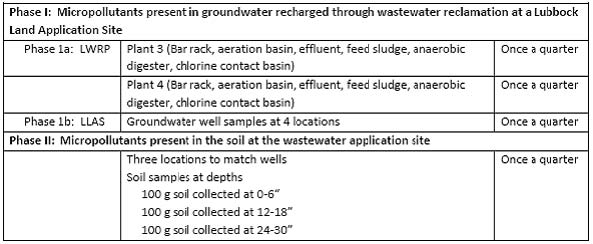Grantee Research Project Results
2009 Progress Report: Texas Tech University Center for Water Law and Policy
EPA Grant Number: EM833085Title: Texas Tech University Center for Water Law and Policy
Investigators: Eckstein, Gabriel , Anderson, Todd A. , Morse, Audra N. , Jeffery, William
Current Investigators: Eckstein, Gabriel , Anderson, Todd A. , Jeffery, William , Morse, Audra N.
Institution: Towson University
EPA Project Officer: Page, Angela
Project Period: June 1, 2007 through May 31, 2010 (Extended to May 31, 2011)
Project Period Covered by this Report: June 1, 2009 through May 31,2010
Project Amount: $432,300
RFA: Targeted Research Grant (2007) Recipients Lists
Research Category: Targeted Research
Objective:
-
Project I: development of a Clearinghouse containing relevant studies and background material;
-
Project II: conduct of a field study to improve understanding into the fates and presence of mixtures of micropollutants in the environment; and
-
Project III: analysis of alternative legal and regulatory strategies for addressing the presence and effects of micropollutants in water systems.
Progress Summary:
-
Home Page – The Home Page provides an introduction to the website, links to the website’s content, and links to other relevant search engines that provide related research and information.
-
About the Project – This page explains the purpose of the website and the overall Project.
-
Study Report – This page will present the Executive Summary of the final Project III Report as well as a link to the full Report in PDF format. The final Project III Report is expected by the end of 2010 or early 2011.
-
Advanced Searches – While each page of the website contains a “simple” search engine that allows users to search through the database, the Advanced Searches page offers more focused search functions based on specific fields in the database. It also offers alternative searches capabilities using Google search engines.
-
Useful Links – This page provides links to other websites and databases containing information relevant to PPCPs and other micropollutants.
-
Disclaimer – This page provides standard disclaimers related to the information presented on the Micropollutants Clearinghouse website.
-
Contact Us – This page offers basic contact information for the Texas Tech Center for Water Law and Policy.
-
Document Information:
-
Title
-
Author(s)
-
Publisher Name
-
Publication Year
-
-
Document Type:
-
Peer-reviewed and Non-peer Reviewed Journal Articles
-
Books and Monographs
-
Conference Materials
-
Media (websites and news stories)
-
R&D Technical Report
-
Inter-Governmental Document
-
Federal Government Document
-
State Government Document
-
Non-US Material
-
Additionally, the Water Policy Institute (PI Professor Eckstein sits on the WPI’s Board of Advisors) revised and issued the release on its website: http://www.huntonfiles.com/files/webupload/WPI_Advisor_Launches_Micropollutants_Clearinghouse.pdf.
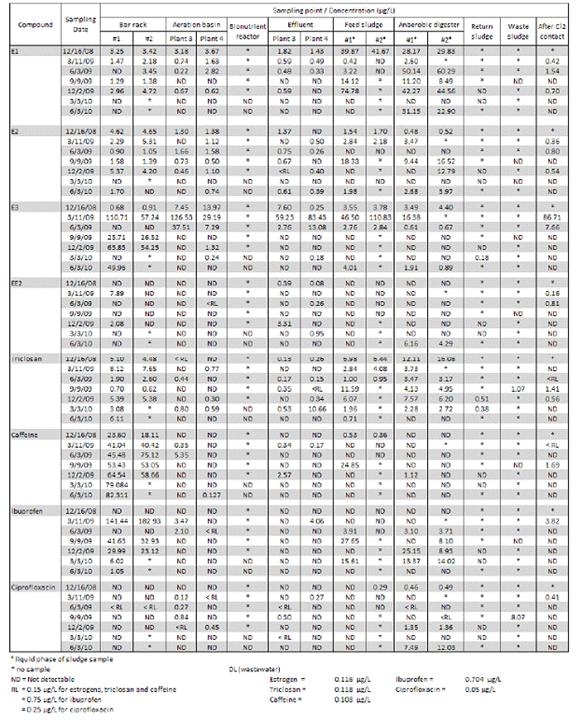

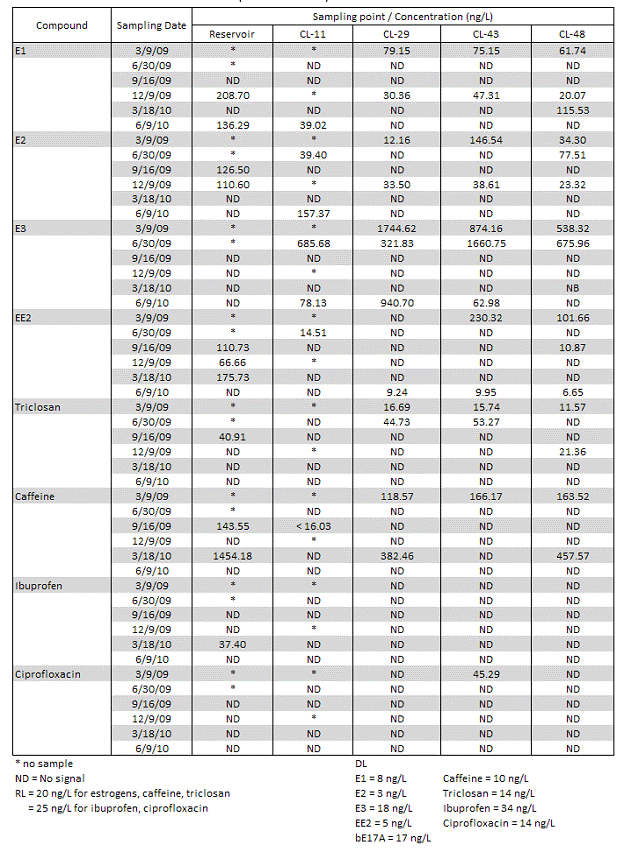

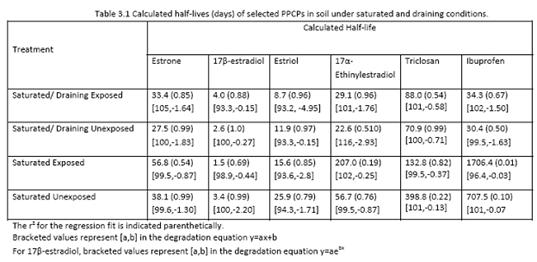
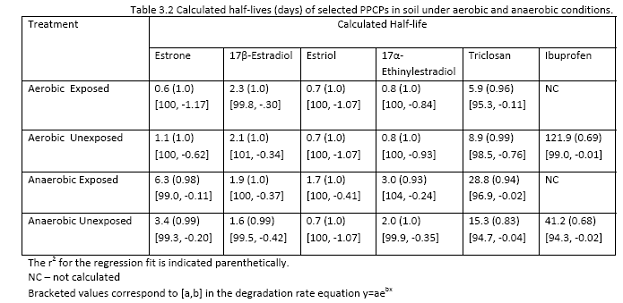
Future Activities:
Planned Activity for the No-Cost Extension Period
During the next project period, we will continue to sample at the Lubbock Wastewater Reclamation Plant and the Lubbock Land Application site. Although the planned project duration was 1.5 years, money has been conserved so that additional samples may be collected and analyzed from our study sites and financial resources will provide support for the graduate student for a total of 3 years. A no-cost extension was requested and the funds will be used to support a graduate student during the no-cost extension year.
Table 4 summarizes the sample collection during each phase of the project. Note that all samples will be analyzed for the micropollutants to be studied in this project (17ß-estradiol (E2), estrone (E1), estriol (E3), and 17a-ethinylestradiol); ciprofloxacin; ibuprofen and triclosan).
Table 4. Project Phases and Sample Collection Summary
Project III: Analysis of Alternative Strategies for Addressing the Presence and Effects of Pharmaceutical and Personal Care Products in Water Systems
Just prior to the end of the last fiscal year, EPA approved the hiring of Dr. George William Sherk as a Consultant to coordinate and work on Project III beginning in September 2009. Dr. Sherk replaced Professor Bill Jeffrey, who left Texas Tech University in May 2009.
Results Project III:
Project III is designed to identify and evaluate regulatory and other programs that are or could be utilized to manage PPCPs and other micropollutants so they do not enter the public water system or aquatic environment in concentrations that would exceed levels determined to be appropriate for protection of human health and the environment.* The project examines 3 basic issues:
- Can existing statutory and regulatory authorities be utilized to collect information about and/or effectively manage PPCPs entering the aquatic environment?
- Are there other alternative management strategies that should be considered?
- What are the relative strengths and weaknesses of these existing authorities and alternative strategies?
The Alternatives Analysis Project will produce a report presenting its findings and at least one article suitable for publication in a university law review that examines the current status of PPCP and micropollutant management and evaluates opportunities for a cohesive and coordinated strategy to manage PPCPs that could enter the aquatic environment.
Between September 2009 and May 2010, Dr. Sherk prepared a research methodology and plan with the assistance of PI Gabriel Eckstein. Dr. Sherk also conducted an extensive literature search, including of documents contained in the Micropollutants Clearinghouse database.
On September 28, 2009, and January 29, 2010, Dr. Sherk travelled to Texas Tech University for in-person meetings with PI Gabriel Eckstein, other Center staff, and with participants working on Projects I and II of the study. The purpose of these meetings was to develop a research strategy and detailed goals for Project III, review material and documents contained in the database generated under Project 1, and review the results, to date, of the material and information generated in Projects I and II.
In May 2010, Dr. Sherk submitted a preliminary draft of the Project III Report. The draft is currently undergoing review and revision. The final Project III Report is expected at the end of 2010 or early 2011, at which time it will be submitted to EPA and placed on the Micropollutants Clearinghouse website.
Review of this information is ongoing. This review has focused on:
- Information needs:
- Identification of programs to collect information regarding PPCPs in the aquatic environment.
- Evaluation of gaps or overlaps in these programs.
- Review of opportunities under existing authorities to collect information regarding PPCPs in the aquatic environment.
- Evaluation of the strengths and weaknesses in existing and potential programs to collect information regarding PPCPs in the aquatic environment.
- Regulatory Requirements:
- Identification of existing regulatory and other programs that are being used to manage PPCPs entering the aquatic environment.
- Evaluation of gaps or overlaps in existing programs.
- Identification of opportunities under existing authorities to manage PPCPs entering the aquatic environment.
- Identification of opportunities not addressed by existing authorities (including other regulatory programs, market-based incentives, and voluntary programs as appropriate) to manage PPCPs entering the aquatic environment.
- Valuation of the strengths and weaknesses in existing and potential programs to manage PPCPs entering the aquatic environment.
All of the documents, data, reports, and other information that have been collected and utilized for Project III can be categorized as secondary data – data that is used for purposes other than those for which they were originally collected. All documents, data, reports, and other information used in Project II came from the results of Project I (development of Micropollutants Clearinghouse website and database). Any material that was located or obtained through other means were first transferred to Project I researchers for review, categorization, and inclusion in the Micropollutants Clearinghouse website and database prior to evaluation for Project III. All documents, data, reports, and other information used in Project III to date has been evaluated only after it was processed and categorized by Project I researchers pursuant to the approved QAPP for Project I and Project III. Professor Eckstein, the Quality Assurance Manager responsible for overseeing the quality assurance and integrity of the data generated for all three Projects, has overseen this process.
Planned Activity for the Next Reporting Period
Over the next six months, Dr. Sherk will continue his research into and analysis of alternative strategies for addressing the presence and effects of PPCPs and other micropollutants in fresh water systems. A second draft of his report, including sections on conclusions and recommendations, is expected on September 3, 2010, while the final Project Report is expected at the end of 2010. This report will identify PPCP management opportunities under existing federal and state statutory and regulatory frameworks and will review alternative approaches (including market-based incentives and voluntary programs) that might be utilized to manage PPCPs that could enter the aquatic environment. Once the Final Report is completed, it will be submitted to EPA and placed on the Micropollutants Clearinghouse website.
References:
American Water Works Association Research Foundation, 2008, Toxicological Relevance of EDCs and Pharmaceuticals in Drinking Water - Executive Summary: American Water Works Association.
Anderson, P.D., D'Aco, V.J., Shanahan, P., Chapra, S.C., Buzby, M.E., Cunningham, V.L., DuPlessie, B.M., Hayes, E.P., Mastrocco, F.J., Parke, N.J., Rader, J.C., Samuelian, J.H., and Schwab, B.W., 2004, Screening Analysis of Human Pharmaceutical Compounds in U.S. Surface Waters: Environmental Science & Technology, v. 38, no. 3, p. 838-849.
Anderson, T., and Morse, A., 2009, EPA Star - Project 2: Investigating the Fare of Mixtures of Micropollutants in the Environment (presentation).
Appel, J.M., 2009, Beyond Fluoride: Pharmacenticals, Drinking Water and the Public Health: http://www.huffingtonpost.com/jacob-m-appel/beyond-fluoridepharmaceu_b_398874.html.
Barnes, K.K., Kolpin, D.W., Meyer, M.T., Thurman, E.M., Furlong, E.T., Zaugg, S.D., and Barber, L.B., 2002, Water-Quality Data for Pharmaceuticals, Hormones, and Other Organic Wastewater Contaminants in U.S. Strems, 1999-2000: U.S. Department of the Interior, U.S. Geological Survey Open-File Report 02-94.
Benotti, M.J., Trenholm, R.A., Vanderford, B.J., Holady, J.C., Stanford, B.D., and Snyder, S.A., 2008, Pharmaceuticals and Endocrine Disrupting Compounds in U.S. Drinking Water: Environmental Science & Technology, v. 43, no. 3, p. 597–603.
Bergeron, J.M., Willingham, E., Osborn, I., C. Todd, Rhen, T., and Crews, D., 1999, Developmental Synergism of Steroidal Estrogens in Sex Determination: Environmental Health Perspectives, v. 107, no. 2, p. 93-97.
Brown, J.B., Battaglin, W.A., and Zuellig, R.E., 2009, Lagrangian Sampling for Emerging Contaminants Through an Urban Stream Corridor in Colorado: Journal of the American Water Resources Association, v. 45, no. 1, p. 68-82.
Buxton, H.T., and Kolpin, D.W., 2002, Pharmaceuticals, Hormones, and Other Organic Wastewater Contaminants in U.S. Streams: U.S. Geological Survey, U.S. Department of the Interior.
Carlrlson, K., Yang, S., Cha, J.-m., Doesken, K., and Davis, J.G., 2004, Antibiotics in Animal Waste Lagoons and Manure Stockpiles: Agronomy News, v. 24, no. 3, p. 7-8.
Carlson, K., Yang, S., and Kim, S.-c., 2004, Antibiotics in the Cache la Poudre River: Agronomy News, v. 24, no. 3, p. 4-6.
Carr, D.L., Morse, A.N., Zak, J.C., and Anderson, T.A., forthcoming, Microbially Mediated Degradation of Common Pharmaceuticals and Personal Care Products in Soil Under Aerobic and Anaerobic Conditions.
Carr, D.L., Morse, A.N., Zak, J.C., and Anderson, T.A., forthcoming, Biological Degradation of Common Pharmaceuticals and Personal Care Products in Soils with High Water Content.
Chalew, T.E.A., and Halden, R.U., 2009, Environmental Exposure of Aquatic and Terrestrial Biota to Triclosan and Triclocarban: Journal of the American Water Resources Association, v. 45, no. 1, p. 4-13.
Christenson, T., 2008, Fish on Morphine: Protecting Wisconsin's Natural Resources Through a Comprehensive Plan for Proper Disposal of Pharmaceuticals: Wisconsin Law Review, v. 2008, p. 141-179.
Collier, A.C., 2007, Pharmaceutical Contaminants in Potable Water: Potential Concerns for Pregnant Women and Children: EcoHealth, v. 4, p. 164–171.
Committee on Toxicants and Pathogens in Biosolids Applied to Land, Board on Environmental Studies and Toxicology, Division on Earth and Life Studies, and National Research Council, 2002, Biosolids Applied to Land: Advancing Standards and Practices (summary): The National Academies Press.
Conerly, O., 2007, Pharmaceuticals and Personal Care Products (presentation), Northeast Water Science Forum, August 8, 2007: Washington, DC, Office of Water, U.S. Environmental Protection Agency.
Cunningham, V.L., Binks, S.P., and Olson, M.J., 2009, Human health risk assessment from the presence of human pharmaceuticals in the aquatic environment: Regulatory Toxicology and Pharmacology, v. 53, no. 1, p. 39-45.
Daughton, C.G., 2003, Non-Regulated Contaminants Emerging Research, Existing and Future Pollutants in Water Supplies: Old Pollutants, New Concerns - New Pollutants, Unknown Issues, in Presented at National Academies, Institute of Medicine: Roundtable Environmental Health Science, Research, and Medicine (EHSRT), Washington, DC, October 16, 2003.
Daughton, C.G., 2003, Cradle-to-Cradle Stewardship of Drug for Minimizing Their Environmental Disposition While Promoting Human Health. I. Rationale for and Avenues Toward a Green Pharmacy: Environmental Health Perspectives, v. 111, no. 5, p. 757-774.
Daughton, C.G., 2003, Cradle-to-Cradle Stewardship of Drug for Minimizing Their Environmental Disposition While Promoting Human Health. II. Drug Disposal, Waste Reduction, and Future Directions: Environmental Health Perspectives, v. 111, no. 5, p. 775-785.
Daughton, C.G., 2004, Chapter 33: PPCPs in the Environment: Future Research -Beginning with the End Always in Mind, in Kümmer, K., ed., Pharmaceuticals in the Environment (2nd ed.): New York, NY, Springer, p. 463-495.
Davis, J.G., 2004, Antibiotics in the Environment: Agronomy News, v. 24, no. 3, p. 1-3.
Donn, J., 2008, An AP Investigation: Pharmaceuticals Found in Drinking Water, PharmaWater - NYC Water: The Associated Press.
Donn, J., 2008, An AP Investigation: Pharmaceuticals Found in Drinking Water, PharmaWater - Philadelphia Drugs: The Associated Press.
Donn, J., 2008, An AP Investigation: Pharmaceuticals Found in Drinking Water, PharmaWater Research: The Associated Press.
Donn, J., 2008, An AP Investigation: Pharmaceuticals Found in Drinking Water – House panel pressed to consider more tracking of pharmaceuticals, contaminants in US waters: The Associated Press.
Donn, J., 2008, An AP Investigation: Pharmaceuticals Found in Drinking Water – Medical facilities making uncontrolled releases of controlled drugs into water: The Associated Press.
Donn, J., 2008, An AP Investigation: Pharmaceuticals Found in Drinking Water -Philadelphia City Council wants local and federal action to curb drugs in drinking water: The Associated Press.
Donn, J., 2008, An AP Investigation: Pharmaceuticals Found in Drinking Water -Philadelphia water officials to address worries over drugs in water and corrected data: The Associated Press.
Donn, J., Mendoza, M., and Pritchard, J., 2008, An AP Investigation: Pharmaceuticals Found in Drinking Water, Pharmawater I - Pharmaceuticals found in drinking water, affecting wildlife and maybe humans: The Associated Press.
Donn, J., Mendoza, M., and Pritchard, J., 2008, An AP Investigation: Pharmaceuticals Found in Drinking Water, Pharmawater II - Fish, wildlife affected by drug contamination in water: The Associated Press.
Donn, J., Mendoza, M., and Pritchard, J., 2008, An AP Investigation: Pharmaceuticals Found in Drinking Water, Pharmawater III - No standards to handle pharmaceuticals in water: The Associated Press.
Donn, J., Mendoza, M., and Pritchard, J., 2008, An AP Investigation: Pharmaceuticals Found in Drinking Water, AP Impact: Health care industry sends tons of drugs into nation's wastewater system: The Associated Press.
Donn, J., Mendoza, M., and Pritchard, J., 2008, An AP Investigation: Pharmaceuticals Found in Drinking Water, AP Investigation: Scant advice on disposal of meds: The Associated Press.
Eilperin, J., 2005, Pharmaceuticals in Waterways Raise Concern: Effect on Wildlife, Humans Questioned, Washington Post: Washington, DC, p. A3.
Ellis, J.B., 2006, Pharmaceutical and personal care products (PPCPs) in urban receiving waters: Environmental Pollution, v. 144, p. 184-189.
Environmental Protection Agency, 2009, Amendment to the Universal Waste Rule: Addition of Pharmaceuticals [excerpts]: Biotechnology Law Report, v. 28, p. 56.
EPA Science Advisory Board Drinking Water Committee, 2009, SAB Advisory on EPA's Draft Third Drinking Water Contamination Candidate List (CCL 3): U.S. Environmental Protection Agency.
Foran, P.G., 2008, Pharmaceuticals in Drinking Water (presentation), NARUC Summer Committee Meetings, July 20-23, 2008, Portland, OR.
Frick, E.A., Henderson, A.K., Moll, D.M., Furlong, E.T., and Meyer, M.T., 2001, Presence of Pharmaceuticals in Wastewater Effluent and Drinking Water, Metropolitan Atlanta, Georgia, July-September 1999, in Hatcher, K.J., ed., Proceedings of the 2001 Georgia Water Resources Conference: Athens, GA, Institute of Ecology, The University of Georgia.
Glassmeyer, S.T., Furlong, E.T., Kolpin, D.W., Cahill, J.D., Zaugg, S.D., Werner, S.L.,Meyer, M.T., and Kryak, D.D., 2005, Transport of chemical and microbial compounds from known wastewater discharges – Potential for use as indicators of human fecal contamination: Environmental Science & Technology, v. 39, no. 14, p. 5157-5169.
Global Water Research Coalition, 2009, GWRC Science Brief - Occurrence and Potential for Human Health Impacts of Pharmaceuticals in the Water System: Water Environment Federation.
Gujarathi, N., and Linden, J., 2004, Potential for Phytoremediation of Antibiotic-Contaminated Water: Agronomy News, v. 24, no. 3, p. 9.
Guo, Y.C., and Krasner, S.W., 2009, Occurrence of Primidone, Carbamazepine, Caffeine, and Precursors for N-Nitrosodimethylamine in Drinking Water Sources Impacted by Wastewater: Journal of the American Water Resources Association, v. 45, no. 1, p. 58-67.
Heberer, T., Feldmann, D., Reddersen, K., Altmann, H.-J., and Zimmermann, T., 2001, Removal of Pharmaceutical Residues and Other Persistent Organics From Municipal Sewage and Surface Waters Applying Membrane Filtration: Water Resources Update, no.120, p. 18-29.
Heberer, T., Verstraeten, I.M., Meyer, M.T., Mechlinski, A., and Reddersen, K., 2001, Occurrence and Fate of Pharmaceuticals During Bank Filtration - Preliminary Results From Investigations in Germany and the United States: Water Resources Update, no. 120, p. 4-17.
Hester, T., Jr., 2008, An AP Investigation: Pharmaceuticals Found in Drinking Water – NJ lawmakers told effects of drugs in water unknown: The Associated Press.
Huang, C.-H., Renew, J.E., Smeby, K.L., Pinkston, K., and Sedlak, D.L., 2001, Assessment of Potential Antibiotic Contaminants in Water and Preliminary Occurrence Analysis: Water Resources Update, no. 120, p. 30-40.
Johnston, K.A., and Sendek-Smith, K., 2010, Muddy Waters: Recent Developments Under the Clean Water Act: Natural Resources and Environment, v. Winter, p. 31.
Jones, K.J., 2006, Endocrine Disruptors and Risk Assessment: Potential for a Big Mistake: Villanova Environmental Law Journal, v. 17, p. 357-388.
Karnjanapiboonwong, A., Morse, A.N., Maul, J.D., and Anderson, T.A., 2010, Sorption of estrogens, triclosan, and caffeine in a sandy loam and a silt loam soil: Journal of Soils and Sediments (accepted).
Karnjanapiboonwong, A., Suski, J.G., Shah, A.A., Cai, Q., Morse, A., and Anderson, T.A., forthcoming, Occurrence of PPCPs at a wastewater treatment plant and in soil and groundwater at a land application site.
Kaye, L., Crittenden, J., and Gressitt, S., 2010, Executive Summary: Reducing Prescription Drug Misuse Through the Use of a Citizen Mail-Back Program in Maine: University of Maine Center on Aging.
Khiari, D., 2007, Endocrine Disruptors, Pharmaceuticals, and Personal Care Products in Drinking Water: An Overview of AwwaRF Research to Date: Drinking Water Research, v. January/February.
Kinney, C.A., Furlong, E.T., Werner, S.L., and Cahill, J.D., 2006, Presence and distribution of wastewater-derived pharmaceuticals in soil irrigated with reclaimed water. Environmental Toxicology and Chemistry, v. 25, no. 2, p. 317–326.
Kitamura, K., Miyajima, K., Higashitani, T., Nakada, N., Komori, K., and Suzuki, Y., 2009, The Effect of Estrogens, River Water, and Treated Wastewater on Vitellogenin Induction of Japanese Medaka: Journal of the American Water Resources Association, v. 45, no. 1, p. 22-34.
Kolpin, D.W., Furlong, E.T., Meyer, M.T., Thurman, E.M., Zaugg, S.D., L.B., B., and Buxton, H.T., 2002, Pharmaceuticals, hormones, and other organic wastewater contaminants in U.S. Streams, 1999-2000: A national reconnaissance: Environmental Science & Technology, v. 35, p. 1202-1211.
LeBlanc, S., 2008, An AP Investigation: Pharmaceuticals Found in Drinking Water - Mass. officials detail steps to keep pharmaceuticals from water supply: The Associated Press.
Long, C., 2008, An AP Investigation: Pharmaceuticals Found in Drinking Water – NYC leaders say city must test drinking water, responding to AP report on drugs: The AssociatedPress.
Luntz, T., 2009, Regulations Might be Needed for 104 Chemicals Found in Tap Water, EPA Says, The New York Times (September 29, 2009 ed.): New York, NY.
Mannina, G.J., Jr., 2006, Medicines and the Environment: Legal and Regulatory Storms Ahead?: Legal Backgrounder, v. 21, no. 11, p. 1-4.
Masters, R.W., 2001, Pharmaceuticals and Endocrine Disruptors in Rivers and On Tap: Water Resources Update, no. 120, p. 1-3.
McGrath, N., 2009, Water Pollution: Pharma's Next Big Headache?, GreenBiz.com (http://www.greenbiz.com).
Mendoza, M., 2008, An AP Investigation: Pharmaceuticals Found in Drinking Water, PharmaWater - Secrecy: The Associated Press.
Mendoza, M., 2008, An AP Investigation: Pharmaceuticals Found in Drinking Water – AP Enterprise: Recent tests detect pharmaceuticals in drinking water of 46 million Americans: The Associated Press.
Mendoza, M., 2008, An AP Investigation: Pharmaceuticals Found in Drinking Water - Communities prevent pharmaceutical contamination with drug takeback programs: The Associated Press.
Mendoza, M., 2008, An AP Investigation: Pharmaceuticals Found in Drinking Water - Ill. orders water testing in reax to AP series; providers elsewhere assure supplies are OK: The Associated Press.
Mendoza, M., 2008, An AP Investigation: Pharmaceuticals Found in Drinking Water – On eve of hearings, White House documents show feds failing to take action on drugs in water: The Associated Press.
Mendoza, M., 2008, An AP Investigation: Pharmaceuticals Found in Drinking Water -Scientists, environmentalists, utilities agree: More testing needed on drugs in drinking water: The Associated Press.
Mendoza, M., 2008, An AP Investigation: Pharmaceuticals Found in Drinking Water - Senators rip EPA over lack of knowledge on drugs in water: The Associated Press.
Mendoza, M., 2008, An AP Investigation: Pharmaceuticals Found in Drinking Water - Texas town releases name of drug found in water; mayor cited terrorism as reason for secrecy: The Associated Press.
Mesner, N., undated, Pharmaceuticals in Drinking Water (presentation): Aquatic, Watershed and Earth Resources, Utah State University.
Moll, D.M., Frick, E.A., Henderson, A.K., Furlong, E.T., and Meyer, M.T., 2001, Presence of Pharmaceuticals in Treated Wastewater Effluent and Surface Water Supply Systems, Metropolitan Atlanta, Georgia, July–September 1999, Proceedings of the 2nd International Conference on Pharmaceuticals and Endocrine Disrupting Chemicals in Water: Minneapolis, MN, National Ground Water Association.
Nidel, C.T., 2003, Regulating the Fate of Pharmaceutical Drugs: A New Prescription for the Environment: Food and Drug Law Journal, v. 58, p. 81-102.
Phillips, P., and Chalmers, A., 2009, Wastewater Effluent, Combined Sewer Overflows, and Other Sources of Organic Compounds to Lake Champlain: Journal of the American Water Resources Association, v. 45, no. 1, p. 45-57.
Poynton, H.C., and Vulpe, C.D., 2009, Ecotoxicogenomics: Emerging Technologies for Emerging Contaminants: Journal of the American Water Resources Association, v. 45, no. 1, p. 83-96.
Pringle, D., 2008, Pharmaceuticals in Drinking Water - Testimony of David Pringle, Campaign Director, New Jersey Environmental Federation, On Behalf of the New Jersey Environmental Federation and Clean Water Action, April 15, 2008, Pharmaceuticals in the Nation’s Water: Assessing Potential Risks and Actions to Address the Issue: Washington, DC, Subcommittee on Transportation Safety, Infrastructure Security and Water Quality, U.S. Senate Environment and Public Works Committee.
Pritchard, J., 2008, An AP Investigation: Pharmaceuticals Found in Drinking Water, PharmaWater - Bottled Water: The Associated Press.
Pritchard, J., 2008, An AP Investigation: Pharmaceuticals Found in Drinking Water, PharmaWater - Treatments: The Associated Press.
Ransdell, H., 2004, Antibiotics: Are They a Threat to Aquatic Ecosystems?: Agronomy News, v. 24, no. 3, p. 10-11.
Rapid Public Health Policy Response Project, 2008, Pharmaceuticals are in the Drinking Water: What Does It Mean?: School of Public health and Health Services, The George Washington University.
Reynolds, K.A., 2003, Pharmaceuticals in Drinking Water Supplies: Water Conditioning & Purification Magazine, v. 45, no. 6.
Reynolds, K.A., 2008, Concern of Pharmaceuticals in Drinking Water: Water Conditioning & Purification, v. 50, no. 4.
Rudzinski, S., 2008, Contaminants of Emerging Concern (presentation), Environmental Health Summit, November 10, 2008: Washington, DC, Office of Water, Office of Science and Technology, U.S. Environmental Protection Agency.
Schoenfuss, H.L., Martinovic, D., and Sorensen, P.W., 2001, Effects of Exposure to Low Levels of Water-Borne 17(beta)-Estradiol on Nest Holding Ability and Sperm Quality in Fathead Minnows: Water Resources Update, no. 120, p. 49-55.
Schulman, L.J., Sargent, E.V., Naumann, B.D., Faria, E.C., Dolan, D.G., and Wargo, J.P., 2002, A Human Health Risk Assessment of Pharmaceuticals in the Aquatic Environment: Human & Ecological Risk Assessment, v. 8, no. 4, p. 657-680.
Sedlak, D.L., and Pinkston, K.E., 2001, Factors Affecting the Concentrations of Pharmaceuticals Released to the Aquatic Environment: Water Resources Update, no. 120, p. 56-64.
Sellin, M.K., Snow, D.D., Akerly, D.L., and Kolok, A.S., 2009, Estrogenic Compounds Downstream from Three Small Cities in Eastern Nebraska: Occurrence and Biological Effect: Journal of the American Water Resources Association, v. 45, no. 1, p. 14-21.
Skadsen, J.M., Rice, B.L., and Meyering, D.J., 2004, The Occurrence and Fate of Pharmaceuticals, Personal Care Products and Endocrine Disrupting Compounds in a Municipal Water Use Cycle: A Case Study in the City of Ann Arbor: City of Ann Arbor Water Utilities.
Snow, D.D., undated, Looking For Traces of Pharmaceuticals in Drinking Water: Water Sciences Laboratory, University of Nebraska - Lincoln.
Snyder, E.M., Pleus, R.C., and Snyder, S.A., 2005, Pharmaceuticals and EDCS in the US Water Industry - An Update: Journal of the American Water Works Association, v. 97, no. 11, p. 32-36.
Southern California Coastal Water Research Project, 2009, Workshop Report: Managing Contaminants of Emerging Concern in California, April 28-29, 2009, Costa Mesa, California: California Ocean Protection Council, California Ocean Science Trust, National Water Research Institute, San Francisco Estuary Institute, Southern California Coastal Water Research Project, University of California, Irvine – Urban Water Research Center, SCCWRP Report No. 0600.
TDC Environmental, 2004, Household Pharmaceutical Waste: Regulatory and Management Issues: TDC Environmental, LLC.
Texas Water Resources Institute, 2010, This is your stream. This is your stream on drugs:Texas A&M University.
The Groundwater Foundation, undated, Pharmaceuticals and Personal Care Products – An Emerging Issue (presentation): The Groundwater Foundation.
Thompson, C., 2008, An AP Investigation: Pharmaceuticals Found in Drinking Water - EPA urges Great Lakes residents not to flush old meds: The Associated Press.
ToxServices LLC, 2008, Approaches to Screening for Risk from Pharmaceuticals in Drinking Water and Prioritization for Further Evaluation: Prepared under the direction of Octavia Conerly, Technical Manager, Health and Environmental Criteria Division, Office of Water, U.S. Environmental Protection Agency, Washington, DC 20016, EPA Contract: C-07-021, WA-B-02, Task 6.
U.S. Geological Survey, 2007, Pharmaceuticals Found in Soil Irrigaed with Reclaimed Water: http://toxics.usgs.gov/highlights/pharm_soils/.
U.S. Geological Survey, 2009, Tracing Wastewater - Using Unique Compounds to Identify Sources of Contamination: http://toxics.usgs.gov/highlights/tracing_wastewater.html.
Vandenbergh, M.P., 2004, From Smokestack to SUV: The Individual as Regulated Entity in the New Era of Environmental Law: Vanderbilt Law Review, v. 57, no. 2, p. 515-628.
Wennmalm, A., and Gunnarsson, B., 2005, Public Health Care Management of Water Pollution with Pharmaceuticals: Environmental Classification and Analysis of Pharmaceutical Residues in Sewage Water: Drug Information Journal, v. 39, p. 291-297.
Wu, J., Rees, P., Storrer, S., Alderisio, K., and Dorner, S., 2009, Fate and Transport Modeling of Potential Pathogens: The Contribution from Sediments: Journal of the American Water Resources Association, v. 45, no. 1, p. 35-44.
Xia, K., Keller, H.L., Bhandari, A., and Wagner, A.J., 2001, Occurrence, Distribution, and Fate of 4-Nonylphenol in Kansas Domestic Wastewater Treatment Plants: Water Resources Update, no. 120, p. 41-48.
Journal Articles on this Report : 1 Displayed | Download in RIS Format
| Other project views: | All 9 publications | 7 publications in selected types | All 6 journal articles |
|---|
| Type | Citation | ||
|---|---|---|---|
|
|
Karnjanapiboonwong A, Morse AN, Maul JD, Anderson TA. Sorption of estrogens, triclosan, and caffeine in a sandy loam and a silt loam soil. Journal of Soils and Sediments 2010;10(7):1300-1307. |
EM833085 (2008) EM833085 (2009) EM833085 (Final) |
Exit |
Progress and Final Reports:
Original AbstractThe perspectives, information and conclusions conveyed in research project abstracts, progress reports, final reports, journal abstracts and journal publications convey the viewpoints of the principal investigator and may not represent the views and policies of ORD and EPA. Conclusions drawn by the principal investigators have not been reviewed by the Agency.

